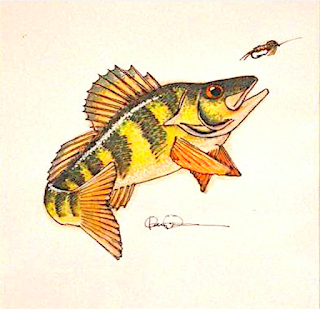Spring and the Nature of Eating
Sunday, September 19, 2021
Trout season is approaching its most glorious phase, that time known as “the sweet of the year.” It’s that blissful time when the season is at its showiest, the air is soft, the streams have cleared, and the trout are rising freely in a most pleasing manner. Which is not to say that they are easily caught—they are still trout, after all. These elegant fish inhabit some of the most poetic and pristine waters, and employ their wiles inscrutably to bewitch and befuddle even the most sophisticated anglers.
So why, over that paean of piscatorial prose, is this scrawl illustrated with a lowly Yellow Perch?
Trout and Yellow Perch tell us something about the way we choose to feed ourselves. Some fishermen (at least those who do not adhere strictly to the canon of catch-and-release) will occasionally consume trout and bass, but eschew “lesser” species such as Bluegills or Yellow Perch. These easily-caught fish actually taste better than the more prestigious species (that’s why they are known collectively as “pan fish”). Trout, especially hatchery-raised fish (which are much more common than truly wild trout ) tend to have soft flesh, with a slightly musty flavor that is probably the result of the food pellets they ate. Bass (especially large-mouth bass) are often caught in muddy or weedy waters, and their flavor can reflect that terroir. Pan fish, on the other hand, are nearly always wild, and their flesh is firm and sweet. So why would someone prefer a food with potentially poorer culinary properties, that is harder to come by?
Those choosy fishermen demonstrate an important aspect of eating: the food itself is only a small part of the eating experience. What we choose to eat is determined by factors that are often at odds with our best interest. We place greater value on the symbolic aspects of foods than on their intrinsic properties.
Why would people (in the past) have preferred white bread to the “lowlier” peasant breads that were cheaper, tastier, and more nutritious? White flour was more labor-intensive, so only the wealthy could afford it—therefore eaters of white bread were visibly part of a higher-status group than eaters of dark breads. Once industrially-produced white flour, became cheap, available to everyone—consequently, losing status. Before long, whole grain breads—made, supposedly, by artisanal methods—gained a newly enhanced status. That status, in turn led people to believe that such breads were “more healthful.” Today’s supermarkets carry a plethora of supposedly more natural breads: not just whole wheat; but honey-laden 12-grain; crusty loaves festooned with seeds of pumpkin, sunflower, and flax; studded with wheat-berries and rolled oats. It’s only a matter of time before we’re offered breads that are indistinguishable from Chia Pets. Being sufficiently well-off to choose “health” over mere sustenance implied higher status, justifying the higher prices of darker breads. Former peasant breads, like pumpernickel and Russian black bread regained their lost status.
Since trout and bass require more effort to catch than plebian pan fish, they likewise confer higher status on those who choose to eat them. Yellow Perch, on the other hand, are so willing to be caught that even a small child, equipped with only the simplest gear (a hand-line, hook, and an old cork will serve nicely) and most rudimentary skills, can easily catch enough to feed their whole family. All that’s required are a few worms, and the ability to wait until the bobbing cork says it’s time to give the line a yank.
Despite the pretentions of fishers of elite species, what they demonstrate is not connoisseurship, but rather the brute power of supply-and-demand. Time is money, so having the leisure time to invest in the sport— not to mention the financial wherewithal to acquire custom-made bamboo fly rods or high-powered bass boats—means that every mouthful of gamefish is more precious than saffron-gilded peacock’s tongues.
At one time lobsters and caviar were so abundant that only servants and slaves had to eat them. The poor were pitied for having to endure the monotony of such mundane fare. Salty caviar was once given away free in taverns to encourage beer sales, while lobsters were so common that they were fed to prisoners, or used to fertilize vegetable gardens. When my mother was growing up, on the Connecticut shore, mussels were abundant—but only poor Italian immigrants collected them. Her Yankee family considered mussels to be trash, and would never touch them. Even during The Great Depression, they chose to eat the tougher (and harder-to-collect) hard-shell clams, Those big quahogs were only suitable for chowder, or chopped for clam pies. I doubt that any of my Yankee ancestors had ever tasted the sweet and tender black mussels that covered every rock in Long Island Sound, were free for the taking.
Why would people shun perfectly-delicious food in favor of something more difficult to obtain, yet not nearly as tasty? Because their self-image is more important, and presumably longer-lasting, than their evanescent dining experiences. Or, to paraphrase Brillat-Savarin, bluntly, “Tell me what you eat, and I will tell you who you think you are.”
In the sweet of the year, I may be savoring the memories of trout I’ve caught and lost… but I’ll actually be tasting the sweet flesh of a few yellow perch.


0 Comments:
Post a Comment
Subscribe to Post Comments [Atom]